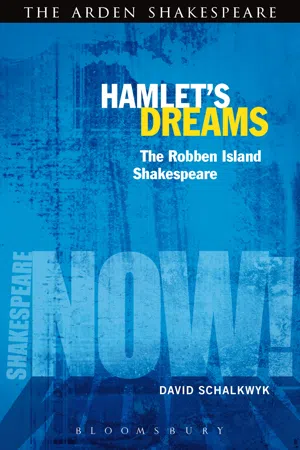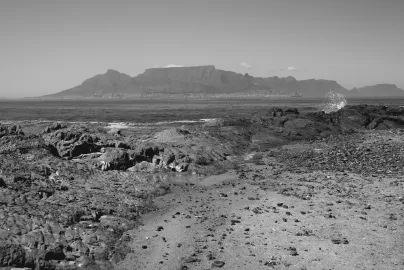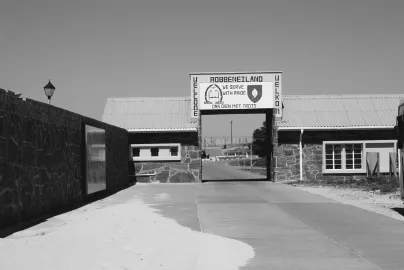![]()
Chapter 1
‘This Island’s Mine’
Most people know of Robben Island only as a political prison: the place where political prisoners, especially Nelson Mandela, were incarcerated for their opposition to the Apartheid regime between 1961 and 1991. ‘The Island’, as it is known among South Africans, is a flat, somewhat desolate outcrop of rock, sand and scrub some 8 miles or 12 km in the Atlantic Ocean off Cape Town. It lies virtually in the shadow of Table Mountain; its oblong form lies slightly closer to the western coast of Table Bay (Figure 1.1).
Figure 1.1 Rocky shore with view to Table Mountain.
Its closest analogue in Western history and mythology is San Francisco’s Alacatraz: both are small, barren islands surrounded by treacherous currents that offer ideal locations for maximum security prisons. It differs from its American counterpart in having been used almost exclusively as a place of political banishment and incarceration. The Island has a much longer colonial history than the 30 years it served as an Apartheid prison, almost all of it as a purgatorial, liminal site of exile and punishment. Members of the indigenous population who resisted the occupation and rule of the early Dutch and subsequently the English settlers were confined to its bleak shores in the seventeenth and eighteenth centuries, while in the nineteenth and early twentieth centuries it was used as a repository for the mentally ill, sexually deviant and medical outcasts like lepers. As Harriet Deacon puts it, ‘It is with the “low” . . . domains that Robben Island has most frequently been associated – with political opposition, insanity, criminality, dirt, disease, the poorer classes, the very bottom of Africa.’1
In 1948 the racialist National Party of South Africa won the general election on its election platform of Apartheid – an ideological distillation of white racial superiority and the separation of races that had informed colonial South Africa almost from the first settlement of Dutch colonists in 1652. The National Party government faced its first critical resistance from the African population on 21 March 1960, when, in a moment of both symbolic and real cataclysm, black protesters were fired upon by police at a township called Sharpville. Sixty-nine people were killed; 180 were wounded. This event, which received world attention, proved to be a turning point in modern South African history. The government declared a state of emergency; the black political organizations, the PAC, which had organized the protest, and the African National Congress (ANC), were banned; tens of thousands of political activists were detained.
Needing a secure place of detention for new detainees and convicted prisoners that it had transformed into political criminals, the Apartheid regime returned the desolate place of colonial exile and incarceration to its former purgatorial role of deportation and abuse.
Its first intake of political prisoners in 1961 consisted overwhelmingly of members of the PAC, a group that had split from the ANC in 1959 because it felt that the ANC was too racially inclusive, excessively open to Communist influence, and not properly focused on the oppression and ultimate liberation of Africans as such. In line with its general ideology of separation (the literal meaning of ‘Apartheid’),2 only male African, Indian and prisoners of mixed race (‘Coloureds’) were interned, after sentence by a court, on Robben Island. Black female political prisoners were consigned to Kroonstad Prison; white female political prisoners were kept at Barberton Prison; white male political prisoners at Pretoria Local Prison; and black political prisoners condemned to be hanged confined to death row in Pretoria Central Prison until their execution (Figure 1.2).
Figure 1.2 The entrance gate.
The earliest years were the harshest, with appalling acts of brutality by warders and almost intolerable conditions. Prisoners were forced to do backbreaking labour, subjected to a near-starvation diet and suffered intolerable cold in winter and heat in summer. The authorities also deliberately inserted common-law prisoners among the political recruits. They believed that the lack of political sensibility, the brutal self-interest and the gang-inflected terrorism of these convicts would both make life intolerable for the new political prisoners and act as disruptive spies and agents provocateurs. One of the early PAC prisoners describes the absolute otherness of these fellows in terms that reflect the racial stereotyping of his political opponents:
The most important prisoner on the island at this time was Robert Sobukwe, leader of the PAC, who, after the end of his sentence, was confined to a tiny cottage on the Island by a special act of Parliament. Sobukwe was held in solitary confinement for 6 years, in almost total isolation, but occasionally he was able to acknowledge the silent salute of work parties passing his cottage.
Nelson Mandela spent a brief period on the Island before he and others comprising the Rivonia group were sentenced to long terms of imprisonment, including life terms, on the Island in 1964.4 Owing to the canny resistance of the political prisoners, conditions gradually improved, with a period of recidivist repression in the late sixties and early seventies.5 The equilibrium of the political prisoners was disturbed in 1976, after a general uprising throughout the country led by young people, when a completely new generation, much more aggressively activist and defiant than the older one, entered the prison. Mandela and three of his fellow prisoners were transferred to Polsmoor Prison in the southern suburbs of Cape Town in 1982. All political prisoners left the Island in May 1991, and it was turned into a Museum. It is currently a World Heritage Site.6
Displacement and Repression
The longer history or memory of Robben Island has been displaced by its most recent past. It has become the signifier of what is in effect a very short period of its existence – the roughly 30 years that the Apartheid regime used it as the place to isolate and control black, male opponents of Apartheid. Furthermore, and perhaps not less inevitably, its general role as a political prison has been displaced by the signifier Nelson Mandela, whose overwhelming figure has tended to stand in for the island as a whole. A recent attempt by the Robben Island Museum to ‘restore dignity for those who died during incarceration on Robben Island’, for example, confines itself to the years between 1963 and 1990.7 The outcasts – the sick, the insane, the deviant – of its earlier history remain forgotten and ignored, their loss of dignity forgotten, repressed or overlooked.
If Nelson Mandela has become a metonym for Robben Island, and if the very local experiences of its prisoners during a relatively brief period are in turn a metonym for the history of the Island as a whole, accounts of such experiences have themselves engaged in displacement and repression. Individual accounts of life as a prisoner on Robben Island undoubtedly confront the reader with a sickening and systematic regime of brutality, hardship and indignity. Many memoirs repeat landmark stories: the extreme brutality of warder Delport at the stone quarry and the reign of terror of the Kleynhans brothers – who buried a prisoner up to his neck in sand for a day and when he asked for water urinated in his mouth; the meanness and small-mindedness of successive commanding officers; the deprivations of censorship and the outlawing of all forms of news; the consistently bad food, ill-fitting clothes and the brutal cold, hunger and psychological deprivation of the punishment of solitary confinement.8
Counter to these stories runs a narrative of solidarity and comradeship – of the gradual political education of the common-law prisoners until they were removed; and of self-discovery and a grand project of universal education, so that by the time Mandela was released, Robben Island had become celebrated as ‘the University’, where a new, politically and generally literate citizenship for a liberated South Africa had been forged and internal differences overcome. Mandela’s own widely read biography, Long Walk to Freedom, offers a peculiar perspective on the Island for a number of reasons: Mandela was isolated with some 30 or 40 prisoners considered to be leaders in a single-cell courtyard (section B) cut off from the general sections which contained thousands of men; he tended to be treated by the authorities with greater respect than other prisoners, and he was neither beaten nor tortured during his pretrial detention; and his autobiography was carefully crafted with a view to achieving reconciliation and a unified nation for the future that he inaugurated as the President of a democratic South Africa.
The representation of Robben Island as, ultimately, the ideologically unified possession of its prisoners has led to some scepticism about the memoirs as factual records of the actual conditions in the prison. Russell Ally, commenting at a seminar at the Institute for Advanced Social Research at the University of the Witwatersrand in 1994, observes:
Fran Buntman records a number of dissenting voices, including that of Saths Cooper (one of the Robben Island Shakespeare signatories), in her comprehensive and insightful Robben Island and Prisoner Resistance to Apartheid.10 But perhaps the clearest indication of the problematic nature of the common story of unified resistance and universal personal growth is the fact that a number of interviews with Robben Island prisoners at the Mayibuye Centre at the University of the Western Cape (including some of Buntman’s) are at the time of writing not freely accessible.
The full story of Robben Island is thus likely to remain relatively obscure. It is perhaps never recoverable, especially as the declared camaraderie begins to fracture in South Africa two decades after Mandela’s release, and members of the present government who were held on Robben Island are perceived to be succumbing to corruption and self-enrichment at the expense of the people for whom the struggle was engaged.
There is thus no single ‘Robben Island’ – there are many, distributed across its differential history, on the one hand, and the various forms of experience of the prisoners who now call it their own, on the other. This differentiated experience stems from the variable conditions in the prison from its inception to the release of the last political inmate – as different prison regimes and commanding officers imposed changing forms of discipline (and indiscipline) in accordance with personal inclination or in response to events in South Africa and the world; as the prisoners themselves began to wrest some control and authority through their own forms of resistance; as conflicts and tensions from beyond the walls impacted upon the prison community itself; and in accordance with a differentiated treatment of different sectors of the prison – for example, the section B, single-cell prisoners like Mandela, the general C-section cell where study was permitted, and – until their removal – the gang-controlled terrain of the common-law prisoners. Desai records a telling interview with Marcus Solomon, who reports of his visit with his daughter to a model of Robben Island at the Mayibuye Centre at the University of the Western Cape:
Solomon’s reference to a distanced ‘they’ who now make decisions about the Island indicates a clearly felt disjunction between Solomon as former prisoner and the new keepers of memory (Figure 1.3).
People tend to speak and write of Robben Island as a set of experiences that belongs to a single place and time and a coherent body of subjects, and Shakespeare’s appeal to those subjects is often assumed to be more or less uniform. Two things stand out against this for my own narrative. First, the claim that Shakespeare constituted a ‘common text’ that united Robben Island’s prisoners is a romantic notion imported from a world in which the Bard is simply assumed to play such a universalizing role everywhere....


